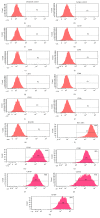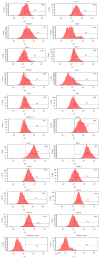Phenotypic and Functional Characterization of Mesenchymal Stem/Multipotent Stromal Cells from Decidua Basalis of Human Term Placenta
- PMID: 27087815
- PMCID: PMC4764756
- DOI: 10.1155/2016/5184601
Phenotypic and Functional Characterization of Mesenchymal Stem/Multipotent Stromal Cells from Decidua Basalis of Human Term Placenta
Abstract
Mesenchymal stem cell (MSC) therapies for the treatment of diseases associated with inflammation and oxidative stress employ primarily bone marrow MSCs (BMMSCs) and other MSC types such as MSC from the chorionic villi of human term placentae (pMSCs). These MSCs are not derived from microenvironments associated with inflammation and oxidative stress, unlike MSCs from the decidua basalis of the human term placenta (DBMSCs). DBMSCs were isolated and then extensively characterized. Differentiation of DBMSCs into three mesenchymal lineages (adipocytes, osteocytes, and chondrocytes) was performed. Real-time polymerase chain reaction (PCR) and flow cytometry techniques were also used to characterize the gene and protein expression profiles of DBMSCs, respectively. In addition, sandwich enzyme-linked immunosorbent assay (ELISA) was performed to detect proteins secreted by DBMSCs. Finally, the migration and proliferation abilities of DBMSCs were also determined. DBMSCs were positive for MSC markers and HLA-ABC. DBMSCs were negative for hematopoietic and endothelial markers, costimulatory molecules, and HLA-DR. Functionally, DBMSCs differentiated into three mesenchymal lineages, proliferated, and migrated in response to a number of stimuli. Most importantly, these cells express and secrete a distinct combination of cytokines, growth factors, and immune molecules that reflect their unique microenvironment. Therefore, DBMSCs could be attractive, alternative candidates for MSC-based therapies that treat diseases associated with inflammation and oxidative stress.
Figures





References
-
- Friedenstein A. J., Chailakhjan R. K., Lalykina K. S. The development of fibroblast colonies in monolayer cultures of guinea-pig bone marrow and spleen cells. Cell and Tissue Kinetics. 1970;3(4):393–403. - PubMed
LinkOut - more resources
Full Text Sources
Other Literature Sources
Research Materials

